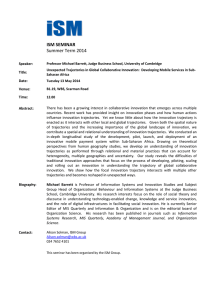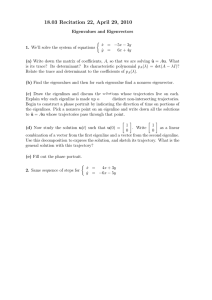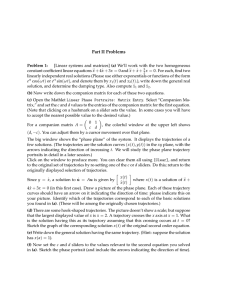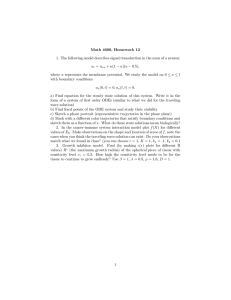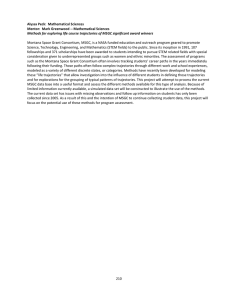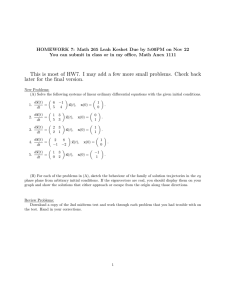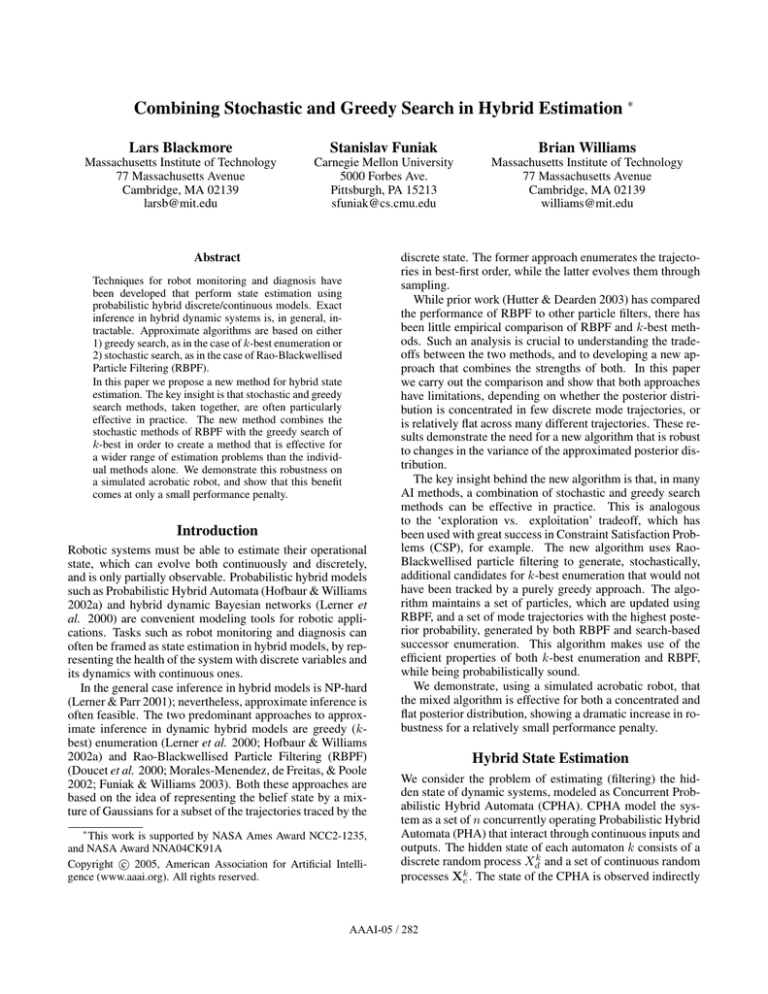
Combining Stochastic and Greedy Search in Hybrid Estimation ∗
Lars Blackmore
Stanislav Funiak
Brian Williams
Massachusetts Institute of Technology
77 Massachusetts Avenue
Cambridge, MA 02139
larsb@mit.edu
Carnegie Mellon University
5000 Forbes Ave.
Pittsburgh, PA 15213
sfuniak@cs.cmu.edu
Massachusetts Institute of Technology
77 Massachusetts Avenue
Cambridge, MA 02139
williams@mit.edu
Abstract
Techniques for robot monitoring and diagnosis have
been developed that perform state estimation using
probabilistic hybrid discrete/continuous models. Exact
inference in hybrid dynamic systems is, in general, intractable. Approximate algorithms are based on either
1) greedy search, as in the case of k-best enumeration or
2) stochastic search, as in the case of Rao-Blackwellised
Particle Filtering (RBPF).
In this paper we propose a new method for hybrid state
estimation. The key insight is that stochastic and greedy
search methods, taken together, are often particularly
effective in practice. The new method combines the
stochastic methods of RBPF with the greedy search of
k-best in order to create a method that is effective for
a wider range of estimation problems than the individual methods alone. We demonstrate this robustness on
a simulated acrobatic robot, and show that this benefit
comes at only a small performance penalty.
Introduction
Robotic systems must be able to estimate their operational
state, which can evolve both continuously and discretely,
and is only partially observable. Probabilistic hybrid models
such as Probabilistic Hybrid Automata (Hofbaur & Williams
2002a) and hybrid dynamic Bayesian networks (Lerner et
al. 2000) are convenient modeling tools for robotic applications. Tasks such as robot monitoring and diagnosis can
often be framed as state estimation in hybrid models, by representing the health of the system with discrete variables and
its dynamics with continuous ones.
In the general case inference in hybrid models is NP-hard
(Lerner & Parr 2001); nevertheless, approximate inference is
often feasible. The two predominant approaches to approximate inference in dynamic hybrid models are greedy (kbest) enumeration (Lerner et al. 2000; Hofbaur & Williams
2002a) and Rao-Blackwellised Particle Filtering (RBPF)
(Doucet et al. 2000; Morales-Menendez, de Freitas, & Poole
2002; Funiak & Williams 2003). Both these approaches are
based on the idea of representing the belief state by a mixture of Gaussians for a subset of the trajectories traced by the
∗
This work is supported by NASA Ames Award NCC2-1235,
and NASA Award NNA04CK91A
c 2005, American Association for Artificial IntelliCopyright gence (www.aaai.org). All rights reserved.
discrete state. The former approach enumerates the trajectories in best-first order, while the latter evolves them through
sampling.
While prior work (Hutter & Dearden 2003) has compared
the performance of RBPF to other particle filters, there has
been little empirical comparison of RBPF and k-best methods. Such an analysis is crucial to understanding the tradeoffs between the two methods, and to developing a new approach that combines the strengths of both. In this paper
we carry out the comparison and show that both approaches
have limitations, depending on whether the posterior distribution is concentrated in few discrete mode trajectories, or
is relatively flat across many different trajectories. These results demonstrate the need for a new algorithm that is robust
to changes in the variance of the approximated posterior distribution.
The key insight behind the new algorithm is that, in many
AI methods, a combination of stochastic and greedy search
methods can be effective in practice. This is analogous
to the ‘exploration vs. exploitation’ tradeoff, which has
been used with great success in Constraint Satisfaction Problems (CSP), for example. The new algorithm uses RaoBlackwellised particle filtering to generate, stochastically,
additional candidates for k-best enumeration that would not
have been tracked by a purely greedy approach. The algorithm maintains a set of particles, which are updated using
RBPF, and a set of mode trajectories with the highest posterior probability, generated by both RBPF and search-based
successor enumeration. This algorithm makes use of the
efficient properties of both k-best enumeration and RBPF,
while being probabilistically sound.
We demonstrate, using a simulated acrobatic robot, that
the mixed algorithm is effective for both a concentrated and
flat posterior distribution, showing a dramatic increase in robustness for a relatively small performance penalty.
Hybrid State Estimation
We consider the problem of estimating (filtering) the hidden state of dynamic systems, modeled as Concurrent Probabilistic Hybrid Automata (CPHA). CPHA model the system as a set of n concurrently operating Probabilistic Hybrid
Automata (PHA) that interact through continuous inputs and
outputs. The hidden state of each automaton k consists of a
discrete random process Xdk and a set of continuous random
processes Xkc . The state of the CPHA is observed indirectly
AAAI-05 / 282
through a continuous observation process Yc . Each discrete
state assignment (mode) Xdk = xkd is associated with a set
of algebraic equations FAE (xkd ) and difference equations
FDE (xkd ) that govern the continuous evolution of the automaton. Given a joint assignment Xd = xd to the discrete
state of all automata 1, . . . , n, the transition and observation
distributions for the continuous state of the overall CPHA,
Xc ∪k Xkc , are obtained by taking the union of equations
for the individual automata (Hofbaur & Williams 2002a),
n
FAE (xkd ) ∪ FDE (xkd ).
θ1
T
actuator: ok
failed θ2
has-ball:true
false
(1)
k=1
Figure 1: Schematic diagram of an acrobatic robot.
Under the assumption of Gaussian noise, this representation
leads to transition and observation distributions that take on
the form of a conditional non-linear Gaussian model
actuator
p(xc,t |xd,t , xc,t−1 ) = N (f (xc,t−1 ; xd,t ), Σx,xd,t )
k=1
The structure in the model can be exploited to compute the
transition model for the desired discrete assignments xd,t
on-line (Hofbaur & Williams 2002a) and aids in further decomposition of the model (Hofbaur & Williams 2002b).
The goal of hybrid state estimation is to determine the
posterior distribution of the hidden (discrete and continuous)
state given all the observations so far, p(xd,t , xc,t |y1:t ). This
distribution can be expressed as a sum of posterior distributions for all trajectories that end in state xd,t :
p(xd,1:t , xc,t |y1:t ). (4)
p(xd,t , xc,t |y1:t ) =
xd,1:t−1
Each summand can be further expanded as a product of the
posterior probability of the discrete mode trajectory xd,1:t
and the posterior distribution of the continuous state, conditioned on this mode trajectory:
p(xd,1:t , xc,t |y1:t ) = p(xd,1:t |y1:t )p(xc,t |xd,1:t , y1:t ). (5)
This decomposition leads to a natural representation of the
belief state as a mixture of Gaussians, one for each reachable
mode trajectory xd,1:t . Given xd,1:t , the second term can
be approximated as a Gaussian, using a combination of a
Kalman Filter and numerical integration techniques, such as
Gaussian Quadrature and Exact Monomials (Lerner 2002).
ball
0.99
0.01
ok
p(yc,t |xd,t , xc,t ) = N (g(xc,t ; xd,t ), Σy,xd,t ). (2)
The means of the transition and observation distributions
are given by the functions f (·; xd,t ), g(·; xd,t ), and the covariances are given by Σx,xd,t , Σy,xd,t . These are obtained
by symbolically solving the set of equations corresponding
to mode xd,t (Eq. 1).
The discrete evolution of the system is described by a
set of probabilistic transitions and the associated guards
over the continuous variables, see Fig. 2. Given this description, the discrete transition distribution for the CPHA,
p(xd,t |xd,t−1 , xc,t−1 ), decomposes as a product of the transition distributions for the individual automata:
n
p(xd,t |xd,t−1 , xc,t−1 ) =
p(xkd,t |xkd,t−1 , xc,t−1 ). (3)
0.9995
0.0005
yes
failed
1.0
θ1 < 0.55
θ1 < 0.55
1.0
1.0
θ1 ≥ 0.55
no
θ1 ≥ 0.55
0.01
0.99
Figure 2: Discrete transition model for an acrobatic robot. If
the actuator has failed, it exerts no torque. When the robot
catches the ball, ball=yes, and the mass of the lower link
increases.
The weight of each mixture component is then computed
using the belief state update (Funiak & Williams 2003)
p(xd,1:t |y1:t ) = b(xd,1:t ) ∝ PO · PT · b(xd,1:t−1 ).
(6)
In this equation, PT p(xd,t |xd,1:t−1 , y1:t−1 ) is the
probability of transitioning to a state xd,t , given the
past mode trajectory and past observations, and PO p(yt |xd,1:t , y1:t−1 ) is the measurement update. Both PT
and PO can be calculated approximately using efficient
methods described in (Hofbaur & Williams 2002a).
Failure Detection with k-best, RBPF
It is intractable to compute the probability in Eq. 5 for
all possible discrete mode trajectories, since their number
increases exponentially with time. A common approach
(i)
is to track only a subset of mode trajectories {xd,1:t },
i = 1, . . . , K and the corresponding continuous estimates
(i)
p(xc,t |xd,1:t , y1:t ), and recursively evolve this set at each
time step. This approach is taken in both Rao-Blackwellised
particle filtering (RBPF) and k-best enumeration.
RBPF works by evolving the trajectories probabilistically.
At each time step, the filter evolves the samples according to
a proposal distribution, which is typically a tractable distribution, such as PT or a product of PT and an approximation
(i)
to PO . Each sample i is then assigned a weight wt that adjusts for the differences in the proposal and the value PT ·PO .
AAAI-05 / 283
<no,ok>
...
tF-1
tF
tF-1
tF
<no,ok>
<no,ok>
...
<no,ok>
?
Stochastic sampling
...
Figure 3: Failure detection with k-best enumeration. In this
figure, the trajectories are shown ordered in terms of their
posterior probability, with the most likely at the top. Trajectories below the dashed line are discarded. The true mode
trajectory is shown in bold.
(i)
Conditioned on the newly evolved state xd,t , we update the
continuous state with a Kalman Filter, as discussed in the
previous section. The samples are periodically resampled
according to their weights, in order to multiply the fitting
samples and discard the unlikely ones.
The k-best filter (Hofbaur & Williams 2002a), on the
other hand, attempts to capture most of the probability space
by greedily expanding the trajectories with the highest posterior probability b(xd,1:t ). Given a set of trajectories, the
filter enumerates a set of successor trajectories in decreasing order of posterior probability, exact up to the approximations in PT and PO and the normalization factor in the
belief state update. For CPHA, this enumeration can be
done efficiently, by expanding the trajectories componentwise and upper-bounding the remaining probability, with a
combination of A* and branch-and-bound search (Hofbaur
& Williams 2002a).
To illustrate the algorithms, consider the model of an acrobatic robot in Figs. 1 and 2. The hidden continuous state
consists of four variables, representing the angles and angular velocities at two joints. Only the angle of the middle
joint is observed, with additive Gaussian noise. The hidden discrete state consists of two variables, actuator and
ball, representing the health state of the robot’s actuator
and whether or not it carries a ball. These two discrete variables together determine the equations governing the evolution of the system, assuming that the weight of the ball is
known.
Suppose that the robot does not carry a ball, and its actuator is functional, up to time step tF , when a failure occurs.
As illustrated in Fig. 3, the k-best enumeration algorithm
maintains the nominal trajectory, and will detect the failure,
as long as a trajectory with the fault transition is among the
set of leading trajectories at (or near) the time when the ac-
<no,failed>
...
...
...
k trajectories
...
...
<no,failed>
<no,failed>
Resampling according
to importance weights
Figure 4: Failure detection with RBPF. The question mark
indicates that the generation of the successor corresponding
to the true trajectory is generated stochastically.
tual fault occurs.1 By contrast, with the RBPF, mode transitions are sampled stochastically (Fig. 4). For the true trajectory to be tracked, the mode transition into the failure state
must be sampled. Since this transition has a low prior many
particles will be needed, in order to detect the fault.
Now, consider a modified model, in which the probability
of catching a ball is 0.5, rather than 0.01. In addition, let the
mass of the ball be small, so that the effect of catching a ball,
on the observations, is relatively small. In this case, the posterior distribution over the trajectories will be flat, as there
will be many trajectories in the belief state that oscillate between the robot having and not having a ball. Initially, these
trajectories will have higher posterior probabilities than the
ground-truth trajectory, because they have much higher priors than the failure, and it takes several time steps before the
evidence for the failure builds up. The RBPF, on the other
hand, will occasionally generate a fault sample even if there
are many alternative trajectories that have a higher posterior
probability. The fault trajectory may thus be present in the
set of trajectories despite having a lower posterior probability than other candidate trajectories. This behavior makes
the RBPF more robust to local maxima.
To summarize, the advantage of k-best enumeration is
that it stores the posterior probability of each trajectory exactly, rather than approximating the probability by a number
of repeated particles. This observation has been noted in the
past (Lerner 2002). However, the ability of k-best enumeration to track the true trajectory is critically dependent on the
number of alternative trajectories with high posteriors in relation to the number of tracked trajectories k. In particular,
if the posterior distribution over the trajectories is flat, kbest enumeration will not consider the right trajectory, and
the RBPF performs better. This observation motivates the
development of our algorithm that combines k-best enumeration and RBPF in a greedy and stochastic search.
1
It is insufficient to consider the fault transition several time
steps later, since at that time, continuous state tracking is no longer
accurate.
AAAI-05 / 284
tF
RBPF particles
k - best
trajectories
tF-1
tP
tP+1
1:
2:
3:
4:
5:
6:
7:
8:
9:
10:
11:
12:
13:
14:
...
RBPF
...
RBPF
Figure 5: Failure detection with our mixed method. At time
tF the true trajectory (bold line) is no longer among the trajectories with the k highest posteriors. However, the true
trajectory is sampled stochastically and becomes a member
of the RBPF particle set. At time tP +1 , the posterior of the
true trajectory becomes large enough for it to be included in
the leading k trajectories.
Hybrid Estimation using a Mixed
Stochastic/Greedy Method
Our proposed algorithm combines the greedy and stochastic approaches, of k-best enumeration and RBPF respectively, to explore the discrete mode trajectories of the system (Fig. 5). The algorithm maintains two sets of trajectories: one set of stochastically generated trajectories, updated
with RBPF, and a separate set of leading trajectories, enumerated according to their posterior probability. The key
idea is to generate successors to the leading k trajectories
through both previously deterministically generated successors to the current k leading trajectories and the candidates
generated by the RBPF. In this manner, the true trajectory
that was discarded by simple k-best enumeration on the basis of having a lower posterior probability than other trajectories can still be tracked in the RBPF particle set and
included in the deterministic set at a later time.
The combination of greedy and stochastic search introduces two challenges. First, in order to enable the comparison of the two sets of trajectories, based on the posterior probability, each particle needs to be augmented with
b(xd,1:t ), the posterior probability of a mode sequence
xd,1:t . This can be updated with Eq. 6, by reusing the values
PT and PO , computed in the importance sampling step of
the RBPF.
Second, trajectories generated by both greedy and
stochastic search must be combined to give the belief state
maintained by the mixed algorithm. Both techniques maintain a number of trajectories and a Gaussian distribution over
the continuous state, conditioned on each trajectory xd,1:t .
The belief state representation in the new algorithm is a mixture of Gaussians, obtained by summation over the k trajectories with the highest b(xd,1:t ) from both RBPF and greedy
successor enumeration.
rbpf candidates ← do rbpf update()
priority queue.push(rbpf candidates)
priority queue.push(kbest trajectories)
while size(new kbest < k) do
candidate ← priority queue.pop()
if (is goal(candidate)) then
candidate ← pop until unique(candidate)
new kbest.push(candidate)
else
new candidates ← expand to successors(candidate)
priority queue.push(new candidates)
end if
end while
do normalization(new kbest)
Figure 6: Belief state update using greedy and stochastic
search.
The pseudocode for the resulting algorithm is shown in
Fig. 6. Lines 4 through 13 of the algorithm implement an A*
search for the k successors with the highest posterior. This
is similar to the method for k-best enumeration described
by (Hofbaur & Williams 2002a). The two key additions are
as follows:
1. Addition of RBPF particles to search queue: In line 1, the
RBPF update step is carried out as described by (Funiak
& Williams 2003), and the resulting particles are added
to the search queue as candidates in line 2. To ensure
soundness of the A* search, candidates are added with
the unnormalized observation function used by (Maybeck
& Stevens 1991).
2. Checking for uniqueness: Many identical candidates are
generated by RBPF and added to the search queue. The
set new kbest, however, holds unique trajectories. Line 7
ensures that unique trajectories only are added to the set
of k best.
In the code shown, line 7 ensures uniqueness by removing
duplicate candidates from the priority queue until a unique
candidate is found. This relies on the fact that identical
candidates will be neighbors in the priority queue. Alternatively, candidates can be checked for uniqueness when they
are pushed onto the queue.
Experimental Results
We carried out experimental analysis with a range of estimation scenarios; shown here are two examples that illustrate
the key results. We used the following two metrics:
1. The fraction of diagnostic faults, defined as
# wrong diagnoses
. Wrong diagnoses are defined as
# time steps
estimates of the discrete state at the fringe that do not
correspond to the same discrete state as the ground truth.
2. The mean square estimation error (MSE) of the continuous estimate corresponding to the MAP diagnosis. This is
defined as ((x̂c,t − xc,t )T (x̂c,t − xc,t ))1/2 , where x̂c,t is
the continuous estimate corresponding to the MAP diagnosis, and xc,t is the continuous state ground truth. This
measure is averaged over all time steps and experiments.
AAAI-05 / 285
0.6
0.4
0.2
0
1
2
10
10
3
0.6
0.2
1
2
10
0.4
0.2
0
1
2
10
3
10
0.8
0.4
10
kbest
rbpf
mixed
0.6
10
kbest
rbpf
mixed
0
0.8
10
0.8
MSE/timestep
fraction of diagnostic errors
kbest
rbpf
mixed
MSE/timestep
fraction of diagnostic errors
0.8
0.6
0.4
0.2
0
3
10
kbest
rbpf
mixed
1
2
10
Number of tracked sequences
10
3
10
Number of tracked sequences
Figure 7: Performance for the actuator failure scenario with
concentrated posterior.
Figure 8: Performance for the failure scenario with the flat
posterior.
Each algorithm was run on 20 random observation sequences with fixed mode assignments. The results given
here show the mean and standard deviation (shown as error bars) of the performance metrics for these runs. For the
mixed method, half of the trajectories were evolved using
the RBPF.
relatively high priors exist, and because the effect of a transition on observations is initially small, a large number of
distinct trajectories will have high posterior probability.
Fig. 8 shows that in this case, the RBPF clearly outperforms the k-best method, both in terms of diagnostic errors and mean square estimation error. The large number
of sequences with high posterior prevents the strict enumeration of the k-best method from considering the initially less
likely failure sequence, except with very large k. The RBPF,
by contrast, samples the actuator failure transition fairly. If
a particle samples the transition close to where it occurred
in reality, the observation likelihood of that particle grows
until it dominates the trajectory space, giving the correct diagnosis. The behavior of the mixed method is similar to that
of the RBPF.
Concentrated Posterior
First, we examined the original acrobatic robot model,
shown in Fig. 1. In this model, the probability of a ball
transition is 0.01 and the probability of an actuator failure
is 0.0005. The mass of the ball is 4kg. Since all transitions have low priors, the true posterior distribution is concentrated in a relatively small number of discrete mode trajectories.
As shown in Fig. 7, the k-best algorithm clearly outperforms the RBPF in both performance metrics, except for
very small and very large k. There is also a qualitative difference in the convergence of each algorithm with increasing
k. Whereas the performance of the RBPF improves gradually as k increases, the k-best algorithm shows a large shift
in performance between k = 10 and k = 20. The mixed
method follows the behavior of the k-best algorithm, with
twice as many particles (since half of the trajectories are
evolved stochastically).
Flat Posterior
Second, we examined a modified model, in which the posterior distribution was spread out among many distinct trajectories. Specifically, we increased the ball transition probabilities from 0.01 to 0.5 and increased the probability of a
failure to 0.01. In addition, the mass of the ball was reduced
to 1kg. Hence, whenever θ1 ≥ 0.55, many trajectories with
Discussion of Results
In the experimental results an interesting pattern emerges:
the k-best algorithm undergoes a phase shift in performance,
depending on whether or not k is large enough for trajectories similar to the ground truth to be tracked. The critical
value of k depends on the concentration of the posterior distribution. If the posterior distribution is concentrated in a
very small number of distinct sequences, the k-best method
will perform well even for small k. For a flat posterior, the
critical value of k is so large when detecting rare events that
many trajectories will need to be tracked, to reliably detect
the fault. In these cases, the RBPF will perform better for
small k, since the distribution is sampled fairly. The mixed
method combines the benefits of the two methods. While its
performance is marginally worse than the RBPF or k-best in
their best-case scenario, it is much more robust to the choice
of model parameters than the RBPF and k-best individually.
AAAI-05 / 286
Conclusion
This paper presented a new algorithm for approximate estimation in probabilistic hybrid models. Our algorithm combines greedy and stochastic search by tracking two sets of
trajectories with k-best and Rao-Blackwellised particle filters, and uses both sets to generate the set of leading trajectories at the next time step. The algorithm is more robust
than k-best and RBPF taken individually, with only a minor
performance penalty.
References
Doucet, A.; de Freitas, J.; Murphy, K.; and Russell, S.
2000. Rao-Blackwellised particle filtering for dynamic
Bayesian networks. In Proceedings of the Conference on
Uncertainty in Artificial Intelligence (UAI).
Funiak, S., and Williams, B. 2003. Multi-modal particle
filtering for hybrid systems with autonomous mode transitions. In Proceedings of SafeProcess.
Hofbaur, M., and Williams, B. C. 2002a. Mode estimation
of probabilistic hybrid systems. In Intl. Conf. on Hybrid
Systems: Computation and Control.
Hofbaur, M. W., and Williams, B. C. 2002b. Hybrid diagnosis with unknown behavioral modes. In Proc. 13th Int.
Workshop on Principles of Diagnosis.
Hutter, F., and Dearden, R. 2003. The Gaussian particle
filter for diagnosis of non-linear systems. In Proc. 14th Int.
Conf. on Principles of Diagnosis, 65–70.
Lerner, U., and Parr, R. 2001. Inference in hybrid networks: Theoretical limits and practical algorithms. In Proc.
17th Annual Conference on Uncertainty in Artificial Intelligence, 310–318.
Lerner, U.; Parr, R.; Koller, D.; and Biswas, G. 2000.
Bayesian fault detection and diagnosis in dynamic systems.
In Proc. of the 17th National Conference on AI.
Lerner, U. 2002. Hybrid Bayesian Networks for Reasoning About Complex Systems. Ph.D. Dissertation, Stanford
University.
Maybeck, P., and Stevens, R. 1991. Reconfigurable
flight control via multiple model adaptive control methods.
IEEE Transactions on Aerospace and Electronic Systems
27(3):470–480.
Morales-Menendez, R.; de Freitas, N.; and Poole, D. 2002.
Real-time monitoring of complex industrial processes with
particle filters. In Proceedings of Neural Information Processing Systems (NIPS).
AAAI-05 / 287


